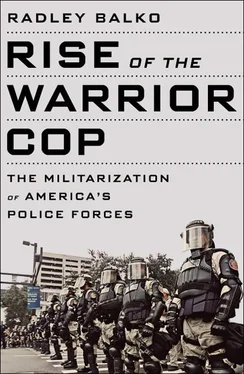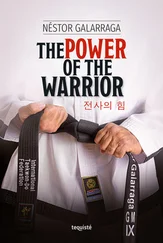Contemporary media accounts of the raid on Dickenson’s ranch described it as a BNDD operation. The initial informant’s tip to the BNDD office in San Francisco came in February, before ODALE was up and running. But once the raid itself went down in April, ODALE had been operational for a month. It isn’t entirely clear that the raid was an official ODALE operation, but it seemed to have all the characteristics of one. ODALE was a transagency endeavor. Ambrose and his staff could detail law enforcement personnel out of several federal agencies to serve on task forces, including BNDD, Customs, the Internal Revenue Service (IRS), and the Bureau of Alcohol, Tobacco, and Firearms (ATF). The nineteen-man assault team assembled to raid Dickenson’s home on April 4 included members of both BNDD and the Humboldt County Sheriff’s Department, along with two federal chemists and an IRS agent.
On the morning of the raid, the nineteen agents, including the dogcatcher, were split into two teams. Half would arrive at the ranch in a Huey helicopter they had borrowed from the US Army. The others donned military jackets and would arrive by car. The car team would drive to the cabin, sneak onto the property, then hide in the trees. When the helicopter landed, the second team would rush out and storm the house. The car team would then drop down from the trees.
To be sure the operation got maximum exposure, Undersheriff Bollman invited the press to come along and watch. (This was another ODALE strategy.) Bollman told the newspaper reporter and two photographers that there was a good chance they’d be witnessing the biggest drug bust in California history. Later, he’d regret bringing them along. The managing editor of the local newspaper would tell Rolling Stone that, were it not for Bollman’s ego, the entire raid would probably have been “tidied up” and few outside Humboldt County would ever have known the name Dirk Dickenson.
One of the federal agents on the raid team was twenty-nine-year-old Lloyd Clifton, who had recently been recruited from the Berkeley Police Department to join the federal narcotics office in San Francisco. Four years before the Dickenson raid, Clifton had pulled over a motorist for a traffic violation. Spotting a bottle of gas in the car, Clifton asked the motorist if it was gas. The man said it was. Bizarrely, Clifton then called the man a “murderer,” for no apparent reason. (He acknowledged as much in a subsequent lawsuit.) When the motorist smirked at the odd insult, Clifton beat him with his baton.
In another odd incident, a California Highway Patrol officer had arrested a young black man for several outstanding traffic warrants. Inside the Berkeley police station, the man said it was a case of mistaken identity. The car was no longer his, and if they let him make a phone call, he could prove that he didn’t own the car when the traffic infractions occurred. They agreed to let him contact the owner. As he was returning from making the call, Clifton—who had nothing to do with the case—confronted the man and asked, “What the fuck are you walking around here for?” He then threw the man into an open elevator and began beating him. Other officers had to pull him off. The man Clifton had beaten was the son of a California Superior Court judge. For that beating, Clifton received a reprimand. In a third incident, he had beaten another black man outside the Berkeley jail, in front of both the man’s mother and a bail bondsman. Clifton claimed he was instigated to violence because the man had called him “a motherfucker.”
If this new federal initiative against street-level pushers was all about projecting aggression and instilling fear, Clifton was a perfect fit.
On the morning of the day he would die, Dickenson and his girlfriend woke at around 9:00 AM. They went out to inspect the tall, wide tree he planned to fell for wood to build some tables. The couple then walked to the property of the man who owned the tree to inquire about buying it. The man happened to be the dogcatcher who had just given them up to the police. He agreed to sell them the tree, knowing they’d shortly be raided by narcotics agents. The two returned to the ranch, stopping first to purchase a bottle of whiskey to celebrate. The couple also planned to build a bathroom that day. The bathtub they’d already built was sitting out on their porch, and they wanted to create a place to put it. They were cleaning out the tub to bring it inside when they first heard the helicopter.
The agents themselves were undercover narcs. They had long hair, mustaches, and unshorn faces. To Dickenson and Arnold, they looked like peers. So when the couple looked up at the low-flying helicopter, they waved. The agents waved back. Judy Arnold described the scene to Rolling Stone reporter Joe Ezsterhas:
Dirk said—“It looks like it’s gonna land.” It was over the house and it was really low. We left the back door open and came back inside the cabin. Boogie and Vernon [the Saint Bernards] weren’t barking. They were calm. Our front door was open and the copter was starting to land. Dust and dirt were coming into the cabin. Dirk walked over and closed the front door. Most of the door was glass. We stood at the corner of the big redwood table in the kitchen facing out the front door. The copter set down and the men jumped off….
I didn’t have anything to be afraid of until I saw the guns… shotguns and rifles and everything. I thought it was some kind of ripoff.
I saw a foot come through the door, the foot and then the door was pushed open. It was busted open. And at the time Dirk turned and ran and told me to run. Before I could do anything they had me. Dirk jumped off the back porch and ran. There’s a terrace back there and a slope toward the woodline. They told me to freeze. There were at least ten of them inside by now. The one who broke the door down, Clifton, ran through the house after Dirk….
It was terrifying. I was shaking. It was like some terrible storm had crashed down out of the sky at us. They held me. The dogs got excited and they were barking. There was mad confusion in the place. 56
Local reporter Richard Harris, who rode along, wrote that the raid resembled “an assault on an enemy prison camp in Vietnam.”
The area wasn’t well suited for a helicopter landing. The gusts generated by the propeller kicked up dirt and rocks and swirled debris. Tree limbs popped as surges of air snapped them from their branches. As Dickenson fled, Clifton called out for him to freeze. It’s likely that Dickenson simply didn’t hear the command over the noise of the helicopter. Arnold says she still wasn’t aware that the men were police. When Dickenson continued to run, Clifton set the sights of his .38 revolver on the young man’s back. He fired one bullet. Dickenson fell to the ground.
Arnold describes what she saw:
I heard somebody say—“He’s been hit!” I didn’t hear the shot. The copter was taking off again and making this insane noise and the dogs were really barking. It was chaos….
I heard he was out there and he’d been hit and I asked if I could go out there and see him. They said no. I said—“Well, can I at least go out on the back porch and see how he is?” So they held me and took me to the back porch. I looked off and I could see him. I saw him move his leg. It was spasmodic, like a twitch….
They took me back to the cabin. They still hadn’t identified themselves. I finally saw a badge on the inside of this guy’s… coat, but they still hadn’t said who they were….
They wouldn’t tell me how he was, wouldn’t say anything…. They put me in the orange truck and I said again—“Well who are you?” That’s the first time they officially told me who they were. 57
The agents searched Dickenson for a gun. He was unarmed. And he’d been shot in the back.
Читать дальше












